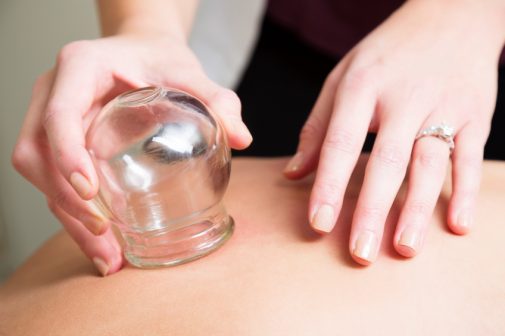What are those purplish-red marks spotted on many Olympians?

If you’ve been watching the Olympics, you have likely noticed Michael Phelps and some other swimmers with large bruises on their backs and shoulders. And while many might be concerned for the swimmer’s health, there’s no need to worry, because those marks are actually a result of a form of Chinese therapy called cupping.
The therapy is gaining attention around the world with so many stars in the spotlight with these prominent marks. Dr. Brian Cunningham, a physical therapist at Advocate Lutheran General Hospital in Park Ridge, Ill., is currently on the medical team for American swimmers at the Olympics and has worked with Phelps.
“The actual term for cupping is myofascial decompression (MFD),” Dr. Cunningham explains. “Myofascial decompression integrates eastern medicine tools with western evidenced-based movement patterns. Athletes who present with restrictions in movement patterns–especially due to adhesions or pain–can get this treatment.”
It works as an alternative to massage and acupuncture. The cups are placed at pressure points on the body to relieve muscle tension and pain. The therapy has been practiced in China for thousands of years.
“The main technique utilizes a suction cup,” says Dr. Cunningham. “The therapist places the suction cup on the area that is most restricted, and it is left on the affected area for 90 to 120 seconds. During that time, the tissues are decompressed, adhesions in the connective tissues are released, and blood flow to that area increases. Once the blood flow increases, the swimmer’s range of motion improves.”
As a result, the swimmer not only enjoys better movement, but he or she can also recover more quickly. Dr. Cunningham explains that quick recovery is especially important for Olympic athletes, because they swim multiple races in a short span of time. The faster they recover, the better their next race (or event) will be. He says these bruises can typically last two to five days.
Related Posts
Comments
10 Comments
About the Author
health enews staff is a group of experienced writers from our Advocate Health Care and Aurora Health Care sites, which also includes freelance or intern writers.


















I have had this procedure done as part of my treatment plan to alleviate back pain. The bruises vary shade depending on the blood flow but it is worth it. I felt like a new person after one treatment.
Thank you so much for the information. I was wondering what those marks are on the swimmers. Thanks for timely information.
Hi, just wanted to point out that cupping is also practiced widely in the Islamic world as it was done by prophet Muhammad (Allah’s blessings be upon him) and is part of the prophetic tradition.
In the Islamic tradition, it is also meant to be a spiritual experience.
What are the possibilities for average individuals with chronic tension issues?
Does the relief outlast the time to heal from the bruising?
Even though I work at reducing my tension (stress), the muscles at the base of my neck are tight most of the time which creates a hindrance to my stress reduction techniques.
Cupping is a therapy that has many different traditions and practices throughout history, and this article is referring to just one of these cupping techniques. Dry cupping is a technique that involves the use of suction cups or jars to accomplish its purpose, while wet cupping does the same and, in addition, small incisions to the cupped area are made for controlled bleeding. The former of these therapies, dry cupping, is the Chinese method that is referred to in this article, whereas the wet cupping method is more of an Islamic tradition. For both kinds of therapies, it was difficult to find science-backed evidence of effectiveness for any of these cupping therapies, but there are many people who have written about and speak about their benefits. I searched through a few scholastic databases and there are very few studies that have been conducted. Many of the studies are conflicting, so it was hard to come to a conclusion based on quantifiable evidence. For example, one study found dry cupping therapy to be effective in treating lower back pain, and in the same study they also concluded that the therapy can be harmful for cancer patients (the American Cancer Society does not recommend cupping by the way). Wet cupping has similar anecdotal evidence for its benefits, however some research-backed studies have shown it to be ineffective and even harmful for some types of patients, not to mention there is a risk of infection due to creating cuts in the skin.
Science aside, I am happy to hear that this therapy has helped people around the world. Thanks for sharing!
Where can you get three treatments? I live in the Barrington IL area.
Thank you so much for the information.
Very insightful! I wish the effects of cupping were a bit more concrete but this is interesting none-the-less!
What other things is this used for?
My current pain doctor does acupuncture with electrical stimulation on me, which helps me a lot, but on my last visit she told me that she had training on cupping and wanted to know if I would like to try it. A friend of mine does it regularly and says it helps her a lot, so I told her I would like to try it. We will see if it is better than acupuncture.